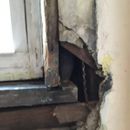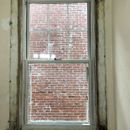Window replacement – insulating weight pockets- please advise?
[9/9 update: I’ve visualized the window insulation as a picture-frame around the window: the window sits within an open wall (the wall is open attic to basement, left to right minus maybe fireblocks); the task as I now see it (at 2pm 9/9/19) is to fit into the sash-weight pocket Rockwool (still working on that install) and air seal the RO before I re-install the replacement window. It seems foolish to just stuff fiberglass up into the pocket and foam will be hard to contain in this assembly. Low expansion/pressure foam above and below complete the ‘frame’.]
I’ve had some difficulty with doing my first solo window replacement re: insulating behind the rough opening. This house is a 1917 single-brick veneer exterior, lath and plaster interior, the wall is (I believe) open from attic to basement. I discovered that there were sash weight pockets behind the RO. After removing the damaged plaster (see the photo below) I noticed that the pockets are open to the wall cavity.
In the Mike Sloggatt video on FHB, “Install Insert Replacement Windows in a Brick Wall”, it is advised: “If your window has weights, it’s a good idea to remove them and fill the window pockets with insulation.” What should be the approach here, to just air-seal the rough opening after filling the space with fiberglass or low-expansion foam as many recommend? My bet is that carefully feeding in Rockwool might work best as 1. compression won’t be such an issue, 2. I don’t have to worry about it flowing out of the pocket and 3. Rockwool tolerates getting wet if that happens.
Once again, any insights would be most welcome. Thanks. – John
GBA Detail Library
A collection of one thousand construction details organized by climate and house part











Replies
Deleted
There are two different things here:
-air sealing (spray foam, caulk)
-insulating (batts)
Stuffing rockwool into cavities insulates but does a pretty poor job of air sealing. Your windows will be almost as cold as if you put nothing there.
By the sounds of it, it is a standard balloon framed house, so first step is air sealing and fixing your falshing details. These houses typically have no water management details around windows/doors, which works while the wall is open, but will cause issues with insulation.
For window weight pockets, I just blow out as much dust as possible then spray the area with water then canned foam the cavity. Water speeds up the curing of the foam and cleans the surface so the foam can stick. Provided you have fixed your window flashing, the drying of the cavity is irrelevant (the cavity will still dry a bit sideways, so small water leaks or condensation is not an issue).
For the rest of your walls, you need to add in the blocking+spray foam in the basement, at each ceiling, at the end of each floor joist bay and finally in the attic.
Whether you insulate down the road really depends on how good your bricks are. If the bricks are very soft (lot of spalling around chimneys is a sign of soft bricks), you are probably best to leave it alone. If not, dense packing the walls makes a huge difference in energy use and comfort.
There is a detail for this scenario included in a report prepared by the Building Science Corporation for the U.S. Department of Energy’s Building America Program titled "Measure Guideline: Deep Energy Enclosure Retrofit (DEER) for Interior Insulation of Masonry Walls". The detail appear in Figure 7, on page 13, and is titled "Window jamb retrofit detail, showing spray foam “fillet” ".
I've attached the relevant page here as a PDF, or you can access the full report at:
https://www.buildingscience.com/documents/bareports/ba-1505-measure-guideline-deer-interior-insulation-masonry-walls/view
Akos - I fear attempting to dense-pack these walls. The opposite side exterior wall of the house has weaker integrity, the space btwn sheathing and brick has apparently widened over time according to the carpenter who did minor repairs on it. Still, I should get an assessment.
As instructed in Building Science article linked by Nathaniel, it would seem that one way would be to remove some of the lath and plaster, enough to open the pocket & insert the 2"rigid foam and air seal with the spray foam.
The other way, as describe by Akos, is to foam from the top - except that the pockets are open to the space btwn the brick and sheathing and might need blocking of some sort. Or would a couple initial applications of foam (with time to dry btwn) fill the peripheral gaps and block foam movement so that the pockets will then be filled with foam?
If it is hard to get access to the cavity, what I've also done is drill a couple of 1" holes through the frame and than fill from there. Not sure what stuffing EPS in there buys, canned foam is cheap, quick and seals. With double brick walls where one side of the cavity is the exterior brick, I just foamed against the brick.
If your brick veneer is peeling away from the studs, you have bigger problems than lack of insulation that need to be fixed first.
Akos - agreed to the state of the veneer, it seems prudent to pay a mason to assess it. The contractor saw that many of the ties were pulled out of the mortar, ie the wall had moved outward and wall failure could happen in 10-15 yrs.
Compared to that, the sash pocket problem is minor. As for that, I am inclined to foam the cavity now.
Thanks.